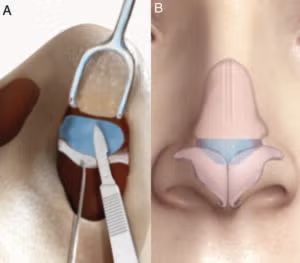What is the current state of semiautomated and fully automated methods for assessing technical skill and performance in otologic and neurotologic surgery?

Preserving the Hearing Health of Military Service Members

Exploring Controversies and Clinical Practices Surrounding Ankyloglossia
Ankyloglossia, or tongue tie, remains a controversial condition regarding its diagnosis and treatment, particularly frenotomy, with ongoing debates about its impact on breastfeeding, speech, and sleep apnea. Recent research and clinical guidelines emphasize the need for careful assessment and multidisciplinary approaches to care.

Secondary Contouring for the Butterfly Graft: Improving Form and Preserving Function
The butterfly graft (BFG) is a surgical technique used to treat nasal airway obstruction by reconstructing the internal nasal valve, but it can lead to external nasal contour irregularities. This study evaluates a secondary contouring procedure designed to address these irregularities while preserving nasal function and improving patient satisfaction.

Unraveling the Mystery of Chronic Cough
Chronic cough affects about 10% of people globally and can persist for many years, often requiring a multidisciplinary approach for diagnosis and treatment. Recent research suggests that chronic cough should be considered a distinct disease, with neurogenic mechanisms playing a significant role in some cases.
Pre-Operative Nodal Biopsy and Extranodal Extension in p16+ Oropharyngeal Squamous Cell Carcinoma
Does the type of pre-operative nodal biopsy influence the risk of ENE in patients with p16-positive OPSCC, and is it associated with adjuvant therapy type?
Factors Associated with High‐Risk Ergonomic Postures During Office‐ Based Rhinology Procedures: A Pilot Biomechanical Analyses
What ergonomic risks do rhinologists face during common office-based procedures, and how does procedure type influence the frequency of high-risk postures?
Comparing Efficacy of Steroid Irrigation, Steroid‐Eluting Sinus Stent, and Both Modalities on Endoscopic Outcomes After Endoscopic Sinus Surgery
What is the comparative efficacy of steroid irrigation, steroid-eluting sinus (SES) stents, and their combination in improving endoscopic outcomes following ESS in patients with chronic rhinosinusitis?
LLMs in Otolaryngology Residency Admissions: A Random Sampling of Interview Questions
Does ChatGPT exhibit demographic bias—based on race, gender, or sexual orientation—when simulating residency selection rankings in otolaryngology?

Questions on NIH Funding Leave ENT Researchers Pondering Next Steps and Leaving Everything Up in the Air
With the Trump administration interrupting research at academic medical centers, court fights over the proposal of a 15% cap on the indirect rate, diversity research de-funded, and a proposal that would cut the NIH budget by 40%, traditionally robust federal support for medical research in the U.S. has eroded, and the research community shows little confidence that this will change in the short term.